Enhancing Gemstone Analysis with UV Flashlights
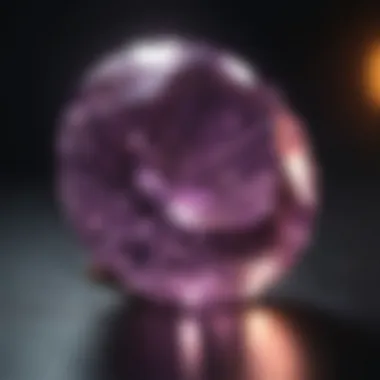
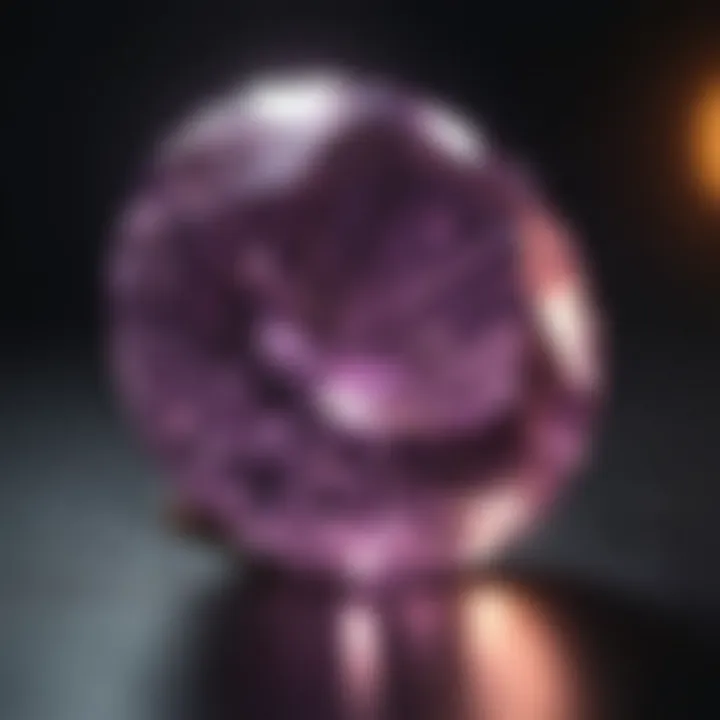
Intro
The study of gemstones goes beyond simple aesthetics. It involves understanding their formation, characteristics, and the various methods employed for their analysis. One tool that has gained prominence in this field is the ultraviolet (UV) flashlight. This article examines the unique role UV flashlights play in gemstone analysis and identification. By revealing qualities that are often invisible under standard white light, UV flashlights facilitate a deeper appreciation of these natural wonders.
This exploration includes the scientific principles of UV light, how it interacts with gemstones, and practical guidance for enthusiasts and professionals. By the end, the reader will appreciate how UV technology enhances the evaluation and appreciation of gemstones, shedding light on aspects that traditional methods might miss.
Gemstone Overview
Understanding gemstones involves delving into their definitions, characteristics, and classifications.
Definition and Characteristics
A gemstone is typically a mineral, rock, or organic material that is cut, polished, and used for jewelry or decoration. Gemstones possess specific optical, physical, and chemical properties. These properties include hardness, brilliance, clarity, and color. Hardness is measured using the Mohs scale, which ranks minerals based on their scratch resistance. This quality is essential for the durability of the stone in jewelry.
Color can vary widely and is influenced by factors like the presence of trace elements. For instance, chromium gives emeralds their green hue, while copper provides the blue for turquoise. Other characteristics, including fluorescence, are particularly relevant when using UV light, as this property can be highlighted or absent depending on the gemstone type.
Classification of Gemstones
Gemstones are classified into two primary categories: precious and semi-precious.
- Precious Gemstones: These include diamonds, sapphires, rubies, and emeralds. They are sought after for their rarity and beauty.
- Semi-Precious Gemstones: This group includes a wide range of stones like amethyst, topaz, and opal. While less rare, they have distinct aesthetics that appeal to collectors.
In addition to these categories, gemstones can be further divided based on specific traits or origins, such as organic stones like pearls and coral. Each classification offers insights into the diverse world of gemstones.
Historical Significance
Gemstones have not only captivated collectors but also held cultural and historical importance across civilizations.
Ancient Uses and Cultural Importance
Historically, gemstones were often linked with power and protection. Ancient Egyptians used lapis lazuli for its beauty and its association with the heavens. In various cultures, amulets adorned with gemstones were believed to possess protective qualities. The lore surrounding these stones contributes to their historical value beyond mere physical charm.
Myths and Legends Surrounding Gemstones
Throughout history, gemstones have inspired countless myths and legends. For example, diamonds were associated with strength and invincibility in ancient India, while rubies symbolized love and passion in medieval Europe.
"Gemstones possess an allure that transcends mere decoration; they are steeped in history and mystery, touching both the spiritual and the aesthetic realms."
Culmination of Section
As we transition into the practical application of UV flashlights in gemstone analysis, understanding the fundamentals of gemstones enhances our ability to appreciate the insights these tools provide. By investigating the microscopic and qualitative features revealed by UV light, enthusiasts and professionals can make more informed assessments of gemstone authenticity and quality.
Preamble to UV Flashlights in Gemstone Evaluation
The use of ultraviolet (UV) flashlights has become increasingly important in the field of gemology. Their unique properties provide gemologists, collectors, and enthusiasts with powerful tools for examination and identification of gemstones. UV light aids not just in the detection of certain physical characteristics, but also plays a crucial role in revealing underlying treatments, enhancements, or synthetic origins of stones.
One significant benefit of UV flashlights is their ability to expose fluorescence in gemstones, an indication that can greatly assist in determining authenticity. Additionally, different gemstones respond differently to UV radiation, adding an extra layer of depth to gemstone analysis. Recognizing the nuances of this interaction is vital for anyone engaged in the realm of gemstones.
Furthermore, the integration of UV light into gemstone evaluation introduces a more scientific approach to identifying gem quality. The nuances of how UV light interacts with various gemstones can lead to more informed decisions regarding gemstone purchasing and valuation.
In sum, the introduction of UV flashlights in gemstone evaluation marks a significant advancement in gemology, leveraging light to increase understanding of gem properties and enhance identification accuracy. This section sets the stage for a detailed exploration of the essential characteristics of UV light and its historical context in the field.
Concept of Ultraviolet Light
Ultraviolet light is not visible to the human eye but is part of the electromagnetic spectrum. It sits just beyond the visible light spectrum, with wavelengths ranging approximately from 10 nanometers to 400 nanometers. UV light is divided into three primary categories: UVA, UVB, and UVC. Each category has its unique properties and applications, but in gemology, UVA, which ranges from about 320 to 400 nanometers, is of particular interest due to its ability to induce fluorescence in many gemstones.
When gemstones are exposed to UV light, they may absorb this radiation and re-emit it at a different wavelength. This fluorescence can appear as colorful glows, which assist gemologists in distinguishing between genuine stones and imitations or treated gemstones. Enhanced understandings of these responses can significantly impact gem identification and valuation, providing essential insights into a stone's history.
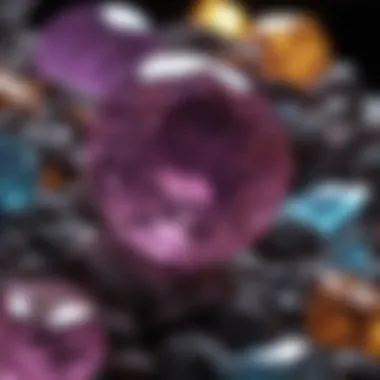
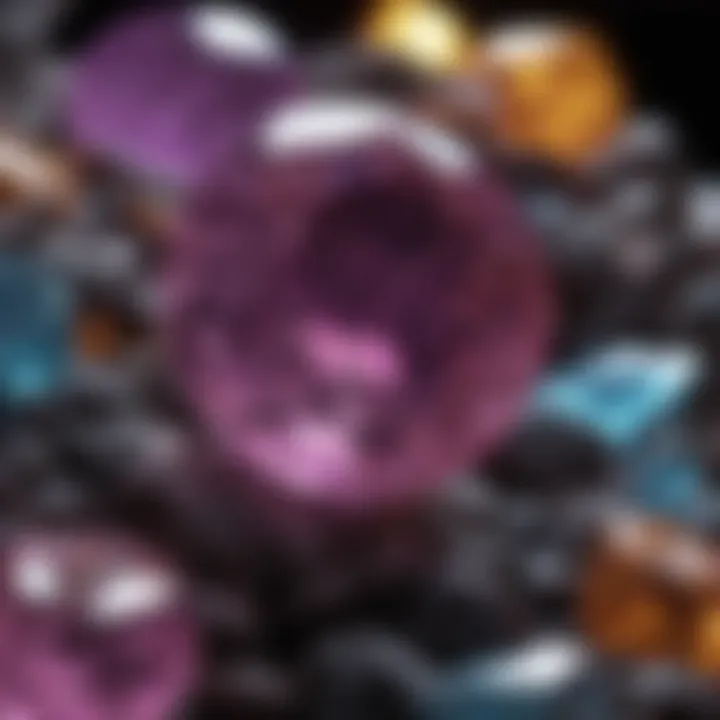
History of UV Technology in Gemology
The application of UV technology in gemology dates back to the mid-20th century when advances in lighting and optics made it possible to harness UV radiation for gemstone analysis. Initially, UV light was mostly used for its ability to reveal fluorescence in certain stones. Key discoveries during this period shed light on what could be concealed under normal observation, igniting a deeper awareness of the need for enhanced examination techniques.
As the field progressed, gemologists began to document various fluorescence patterns within a broad range of gemstones, contributing to a foundational understanding of gem properties. The era saw significant milestones, such as the differentiation of natural and synthetic stones through their distinct UV responses. Over time, innovations in UV flashlight design made these tools more accessible for both professional gemologists and enthusiasts alike.
Today, the technology has advanced significantly, with various UV flashlight models available that cater to specific gemological needs. As we continue to deepen our understanding of fluorescence and UV technology, gemology stands to benefit immensely from these scientific advancements.
Understanding Gemstones and their Properties
In the realm of gemology, understanding gemstones and their properties serves as a fundamental aspect to achieve accurate identification and analysis. Knowledge of the classification, physical and chemical characteristics, as well as unique optical behaviors of gemstones is critical when employing UV flashlights for gemstone analysis. This knowledge enables both enthusiasts and professionals to appreciate the intricate nature of gemstones and enhances their evaluation process.
Classification of Gemstones
Gemstones are classified into two main categories: precious stones and semi-precious stones. This classification provides a framework for understanding their rarity and value. Precious stones typically include diamonds, rubies, sapphires, and emeralds. These are highly sought after, often because of their beauty, durability, and historical significance. Semi-precious stones encompass a wider range, including amethyst, turquoise, and garnet. Their qualities may vary widely, but they often offer unique colors and patterns that make them appealing.
The classification is not merely an academic exercise; it has significant implications for their treatment and market value. UV flashlights can reveal enhancements or treatments made to both categories, which is an essential consideration in determining true worth.
Physical and Chemical Properties
The physical and chemical properties of gemstones include aspects such as hardness, refractive index, specific gravity, and chemical composition. Hardness, measured by the Mohs scale, defines a gemstone's scratch resistance. For example, a diamond, rated as a ten, is the hardest known natural material, whereas talc, rated as one, is very soft. This aspect can influence the gemstone's durability in jewelry.
Refractive index is another crucial property, which describes how light bends as it passes through a gemstone. This property is vital in assessing how a stone will sparkle. Furthermore, specific gravity indicates the density relation of a gemstone when compared to water, allowing gemologists to distinguish stones that may look similar but differ in composition.
Chemical composition drives the stone's color and clarity. For instance, trace elements can lead to unique hues, such as chromium in emeralds, which brings forth their vivid green color.
Fluorescence in Gemstones
Fluorescence is one of the resonant features that can be examined under UV light. This phenomenon occurs when a gemstone absorbs UV radiation and re-emits it as visible light. Different gemstones exhibit varying degrees of fluorescence; for example, some diamonds and rubies may glow vividly under UV light, while others may not respond at all. Understanding these fluorescence behaviors is critical for both identification and verification processes.
Such glowing properties can reveal information about a gemstone's enhancements or treatments, aiding in the determination of authenticity and overall quality. In some cases, fluorescence could also affect a gemstone's value, complementing other assessment data presented by a UV flashlight examination.
Fluorescence behavior can be used to identify gemstones like diamonds and rubies and also to detect treatments, serving as a significant tool in gemology.
In summary, a comprehensive grasp of gemstones and their characteristics provides gem enthusiasts, collectors, and professionals with the necessary toolkit for enhanced analysis. The integration of UV flashlights into this practice illuminates hidden qualities and validation methods. This understanding lays the groundwork for deeper appreciation and more precise identification in the fascinating world of gemstones.
Principles of UV Light Interaction with Gemstones
Understanding how ultraviolet (UV) light interacts with gemstones is fundamental to the processes of analysis and identification in gemology. UV light can reveal properties that are not visible under standard lighting, making it a powerful tool for both enthusiasts and professionals in the field. This section presents the mechanisms behind UV absorption and emission and discusses the variances observed among different types of gemstones.
Mechanisms of UV Absorption and Emission
When UV light encounters gemstones, it interacts with the structure of the materials. This interaction involves absorption and subsequent emission of light. Different gemstones have unique compositions that determine the wavelengths of UV light they absorb and the colors they emit.
- Absorption: When UV light hits a gemstone, certain wavelengths may be absorbed by the crystal structure. This absorption is often due to the presence of trace elements or defects within the crystal lattice. For example, the presence of iron in some quartz can cause it to absorb UV light, leading to distinctive reactions that are helpful in identification.
- Emission: After absorption, gemstones may re-emit light at longer wavelengths, which is typically visible in the form of fluorescence. This effect can vary significantly from one type of gemstone to another. For instance, some diamonds exhibit strong fluorescence under UV light, while others might not fluoresce at all. The specific wavelengths of light emitted can provide clues about the gemstone's identity and treatments.
In employing UV flashlights during gemstone analysis, the professional or enthusiast should consider the crystal structure and composition of the sample, as these factors greatly affect how the gemstone will respond to UV light.
Variances in Response Among Different Gem Types
Not all gemstones react similarly to UV light, and recognizing these variances is crucial for accurate identification. Some notable responses include:
- Fluorescent Gemstones: Certain stones like opals and fluorite are known for their vivid fluorescence under UV light. Their brightness and color can help indicate quality and potential enhancement treatments.
- Non-Fluorescent Gemstones: Other gemstones, like sapphires and rubies, might not show any fluorescence. While they may absorb UV light, their lack of visible emission can complicate identification without additional tests.
- Color Changes: For some stones, exposure to UV light may induce temporary or permanent color changes. This phenomenon can signify treatments, such as radiation exposure or dye applications, which affect market value.
In summary, the interaction of UV light with gemstones is a complex process that provides significant insights into their properties and authenticity. Recognizing the mechanisms of UV absorption and emission, as well as understanding the variances among different gemstone types, equips gemstone enthusiasts and professionals with the knowledge to make informed assessments.
"The careful analysis of gemstones under UV light can reveal hidden qualities that define their worth and identity."


By comprehending these principles, one can better utilize UV flashlights for effective gemstone evaluation.
Benefits of Using UV Flashlights for Gemstone Analysis
The utilization of ultraviolet (UV) flashlights offers several benefits that enhance the process of gemstone analysis. One significant advantage is the ability to reveal unique characteristics of gemstones that are otherwise invisible under normal light. UV light can uncover treatments or enhancements that gemstones may have undergone. This phenomenon is crucial for collectors and professionals, as the authenticity and quality of gemstones often rely on understanding their treatments.
UV flashlights are also valuable in conducting scientific validation of gemstones. The insights gathered from these tools assist gemologists in confirming the origin and legitimacy of the stones they handle. When dealing with high-value stones, ensuring their authenticity is non-negotiable.
In summary, the benefits of using UV flashlights in gemstone analysis include:
- Detection of treatments that could affect value
- Confirmation of gemstone authenticity, thus preventing fraud
- Identification of fluorescence, which can add to the beauty or rarity of the stone
These advantages make UV technology a vital part of gemstone evaluation.
Enhanced Detection of Treatments and Enhancements
One of the most notable contributions of UV flashlights in the realm of gemology is their exceptional ability to detect treatments and enhancements in gemstones. Treatments can vary significantly, from simple processes like cutting and polishing to more complex enhancements, such as the application of oils or resins. Under UV light, certain treatments will fluoresce or absorb light differently compared to untreated stones. This distinct response can serve as a red flag for experts examining the gem.
Detecting enhancements is essential for various reasons:
- Value Degradation: Many enhancements may artificially inflate the value of a stone. Understanding these alterations helps to ascertain genuine worth.
- Ethical Considerations: Disclosure of treatments is vital in the buying and selling market. Knowledge gained through UV analysis promotes transparency.
- Identification of Enhanced Gemstones: Differentiating between natural and treated stones can influence market trends and consumer choices.
Thus, the role of UV flashlights in recognizing treatments cannot be overstated. They offer gemologists a reliable method to scrutinize the authenticity of gemstones more thoroughly.
Scientific Validation of Gemstone Authenticity
The scientific validation of gemstone authenticity is another critical area improved by the use of UV flashlights. In a market rife with imitation stones, establishing authenticity is paramount. UV light allows gemologists to obtain data that supports their identification claims, based on the specific reactions gemstones exhibit under UV illumination.
For example, certain minerals or inclusions may exhibit unique fluorescence patterns unique to specific gem types. This analysis can help differentiate between similar-looking materials and confirm their identity based on empirical evidence. Furthermore, in instances where a gemstone is purported to be of a certain origin, the reactions in UV light can corroborate or refute such claims.
Moreover, the exploration of scientific validation includes:
- Research Approaches: Incorporating UV flashlights into research protocols strengthens the evaluation framework of gemstones.
- Technological Advancements: As UV technology evolves, methods and tools used for validation become more accurate and refined.
Practical Applications of UV Flashlights
Ultraviolet flashlights serve as an invaluable tool in the field of gemology. The role of these devices extends beyond mere visual enhancement; they enable professionals and enthusiasts alike to unveil the hidden aspects of gemstones. The increased accuracy in identification and the understanding of gemstones' properties underscore the significance of practical applications of UV flashlights.
Step-by-Step Guide to Using UV Flashlights
Using a UV flashlight is not overly complex, but it requires certain care and attention. Here’s a quick guide to assist users in harnessing the potential of this device:
- Select the Right Flashlight: Choose a UV flashlight that emits the correct wavelength. Most gemologists use UV light in the range of 365 nm to 405 nm.
- Prepare the Workspace: Ensure the environment is dark. Ambient light can interfere with the effectiveness of UV illumination.
- Handle Gemstones Carefully: When examining gemstones, hold them securely. Avoid touching the surface with bare hands, as oils can affect fluorescence observations.
- Illuminate and Observe: Switch on the UV flashlight and gradually move it over the gemstone. Watch closely for any signs of fluorescence, color changes, or inclusions that become visible.
- Document Your Findings: Take notes or pictures of your observations. This record can help in further analysis or verification of gemstone identification.
This systematic approach aids users in maximizing the benefits of UV flashlights during gemstone evaluations.
Field vs. Laboratory Use
The context in which UV flashlights are used often dictates their effectiveness. The contrast between field and laboratory settings is quite notable.
- Field Use: In outdoor conditions or at gem shows, the portability of UV flashlights is essential. They allow quick examinations but may have limitations due to uncontrolled lighting conditions. Users must adapt and work quickly, often relying on experience to interpret immediate observations.
- Laboratory Use: In a more controlled environment, laboratory-grade UV flashlights provide stability and enhanced focus on gemstones. The ability to isolate samples from external factors allows for more detailed analysis. Here, gemologists can apply various techniques, such as spectroscopy, to further understand a gemstone's characteristics.
"The use of UV flashlights in gemology not only facilitates identification but also deepens the understanding of gemstone treatments and their natural features."
Such tools are transforming how gemstones are analyzed and appreciated, fostering deeper insights within the gemology community.
Limitations and Challenges of UV Flashlight Use
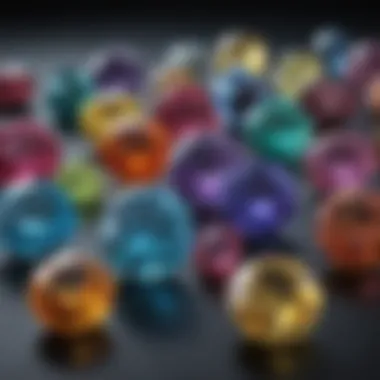
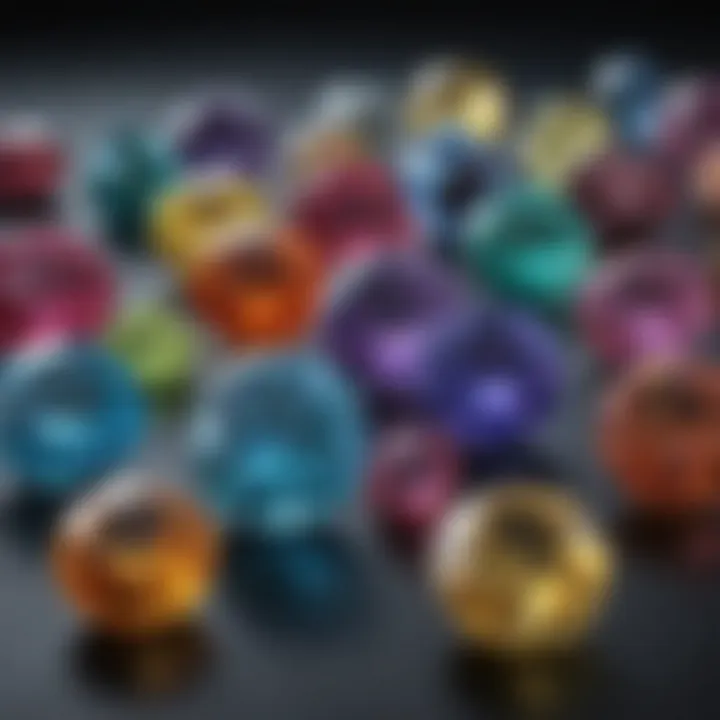
In the realm of gemstone analysis, the use of ultraviolet (UV) flashlights presents many opportunities. However, it is also crucial to address the limitations and challenges associated with their use. Understanding these limitations is essential for both enthusiasts and professionals. It allows them to optimize their methods and avoid potential pitfalls in gemstone evaluation.
Understanding Limitations of UV Luminescence
UV luminescence is not universally applicable to all gemstones. While some stones exhibit striking fluorescence, others may show little to no response under UV light. For instance, diamonds typically do not fluoresce in the same way as minerals like fluorite or willemite. This variance can lead to misinterpretation during gemstone identification.
Additionally, certain treatments can affect how a gemstone reacts to UV light. For example, some synthetic stones might fluoresce in a manner similar to their natural counterparts, complicating the distinction between the two. This aspect underscores the need for a comprehensive understanding when relying on UV light for authenticity assessments.
Other factors, such as the condition of the gemstone, can also influence luminescence. Any surface treatments, coatings, or inclusions might impact the results of a UV examination. Therefore, it is important to recognize that the absence of fluorescence in some stones does not equate to their lack of authenticity or quality.
Potential Safety Precautions
Working with UV flashlights demands attention to safety. UV radiation can pose health risks, particularly with prolonged exposure. Here are several safety considerations to keep in mind:
- Personal Protective Equipment (PPE): Always wear UV-blocking goggles to protect the eyes from harmful rays.
- Controlled Environment: Conduct gemstone assessments in an area with limited UV exposure to ensure safety.
- Limit Exposure Time: Minimize the amount of time spent using UV light directly on gemstones, especially during examination.
It is also advisable to inform others when using UV flashlights in shared spaces to prevent accidental exposure. The combination of responsible usage and adequate preventative measures can reduce the risks associated with UV technology in gemstone analysis.
Key Takeaway: Awareness of the limitations and potential dangers associated with UV flashlights is critical for effective and safe gemstone identification.
Future Trends in UV Technology for Gemstones
The use of ultraviolet light in the examination of gemstones is evolving. Understanding these future trends offers valuable insights for gemstone enthusiasts and professionals alike. As technology improves, so too does the capacity for precise and effective gemstone analysis. New tools, techniques, and methodologies promise to enhance the quality of gemstone identification and appreciation. This section addresses the innovative tools that are emerging and the ongoing research and development in this field.
Innovative Tools and Technologies
The advancement of UV technology in gemology is likely to lead to the introduction of several innovative tools. These may include more sophisticated UV flashlights that utilize a broader spectrum of UV light. For instance, tools that can switch between shortwave and longwave UV light can expose distinctive features of gemstones that were previously undetectable. Additionally, portable UV LED systems are in development. They offer greater energy efficiency and improved longevity compared to traditional UV lamps.
Further, integration with smart technology is becoming a trend. For example, mobile applications that translate the UV response of gemstones into readable data can assist gemologists in their evaluations. This eliminates subjective interpretation and enhances accuracy. Another promising innovation is the use of UV imaging cameras. These can capture and analyze luminescence patterns more effectively, providing gemologists with a deeper understanding of gemstone properties.
Research and Development Perspectives
The future of UV technology in gemology not only rests on existing tools but also on ongoing research and development. Researchers are exploring the interaction of different gemstone materials with UV light at a molecular level. This could lead to the discovery of unique fluorescence patterns that may correlate with specific geological conditions. Continuous studies on the energy levels of gemstones may open new avenues for determining authenticity.
Collaboration between universities and the gemological community is increasing. Such partnerships foster innovation as they focus on practical applications of UV technology in gemstone analysis. Discussions at academic conferences are addressing how to advance methodologies for gemstone evaluation. Furthermore, funding is being directed towards projects aimed at discovering novel applications of UV technology, which is an exciting prospect for the future.
"The embrace of advanced technology is crucial for the evolution of gemstone analysis. This ensures that gemologists remain at the forefront of accuracy and authenticity."
These trends underscore a pivotal shift in the way gemstones might be evaluated moving forward. For anyone looking to enhance their understanding of gemstones, staying current with these developments will be essential. Adopting these innovations will also lead to more reliable gemstone identification. In a market where authenticity matters significantly, embracing new UV technology can provide a competitive edge.
Ending
In this article, we have examined the role of UV flashlights in the analysis and identification of gemstones. This exploration underscores several important elements that define this topic.
Firstly, the key benefits of utilizing UV light in gemology cannot be overstated. Enhanced visibility of certain gemstone characteristics, such as fluorescence and treatments, allows for more accurate assessments. This is particularly beneficial for gemologists and jewelers who seek to ensure authenticity and quality in their offerings. Moreover, the ability to identify synthetic alterations further broadens the scope of knowledge for anyone involved in gem commerce.
Secondly, practical considerations have been addressed. Understanding how to effectively use UV flashlights provides both enthusiasts and professionals with a tool that can elevate their gemstone evaluation practices. Instruction on field versus laboratory applications is crucial for ensuring that these tools are utilized to their full potential. The correct handling and understanding of limitations and safety precautions have also been emphasized, reflecting a responsible approach to UV flashlight use.
Thirdly, the article discusses future trends in technology, hinting at innovations that may enhance the efficacy of UV light in gemology even further. With ongoing research and development, the integration of advanced tools promises to optimize gemstone analysis and identification processes. Thus, keeping abreast of these advancements will be imperative for professionals in the field.
"The integration of UV flashlights in gemstone evaluation is not merely a trend; it’s a profound enhancement of the gemological practice."
Ultimately, the significance of UV flashlights in gemstone analysis extends beyond mere curiosity. It represents a confluence of science and art, where light unveils the hidden beauty and complexities of gemstones. Through understanding and applying these techniques, gemstone enthusiasts, collectors, and professionals alike can deepen their appreciation and knowledge of this fascinating subject.
Summary of Key Points
- Enhanced Detection: UV flashlights reveal unique qualities in gemstones, enhancing detection of treatments and enhancements.
- Scientific Validation: These tools support authenticity in gemstone identification and evaluation.
- Practical Applications: Knowledge of how to use UV flashlights is crucial for effective analysis in both field and laboratory settings.
- Future Trends: Advances in UV technology promise to further refine gemstone examination practices.
Implications for Gemstone Enthusiasts and Professionals
The implications of using UV flashlights in gemology are significant for both enthusiasts and professionals. For enthusiasts, understanding the properties of UV light can enhance their journey in gemstone collection. They can make more informed choices, recognizing treated or synthetic stones more readily.
Professionals, including jewellers and appraisers, benefit from the increased accuracy UV flashlights provide. This technology strengthens reputations through validated gemstone authenticity. Continuous education on advancements in UV tools also prepares them to adapt to future developments in the field. As interest in sustainable and ethically sourced gemstones grows, the role of UV flashlights may become even more critical in verifying the legitimacy of gemstones offered on the market.







